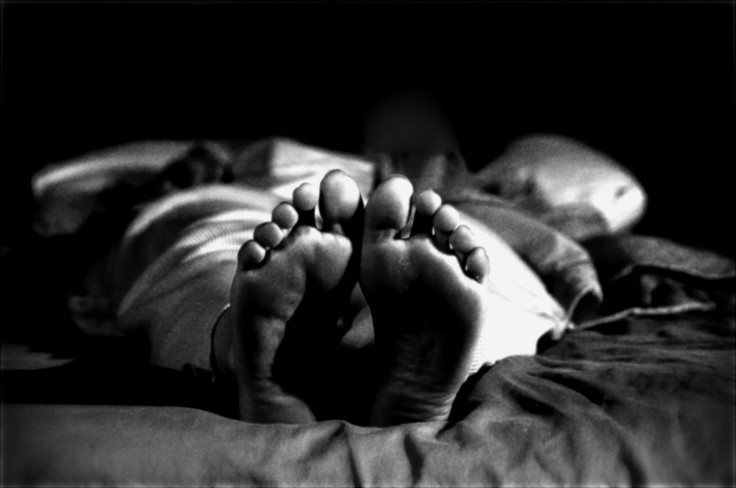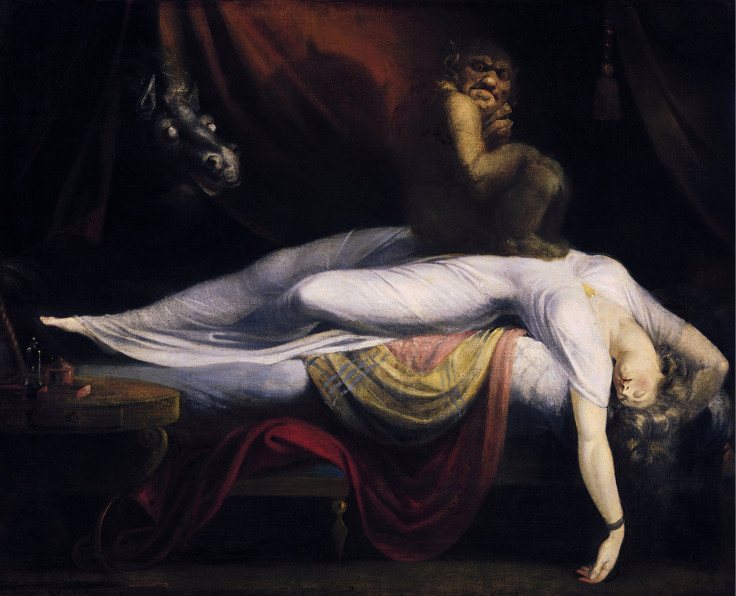Sleep Paralysis And Demons In The Bed

With the ghastly specter of Halloween approaching us this week, Medical Daily will be exploring the science behind some of the more terrifying experiences in our day-to-day lives via a mini-series of articles. Enjoy!
The Demon In Your Bed
It’s a dark Sunday morning as your eyelids lazily lift up. An early dawn, the moonlight is still struggling against the sun’s inevitable rise from over the horizon. You scan the room and see the reminders of a previous night spent well — party clothes haphazardly splayed onto the dresser opposite you. Feeling the autumn breeze on your exposed feet from beneath the covers, however, you begin to get a deepening sense of dread in the pit of your stomach. Something is wrong.
There’s a tightness in your chest, as if someone had decided to scoot on over and plop down on your solar plexus, and your breathing is shallow. Your eyes dart to the slightly ajar windows and you swear that the shadows by the curtains are starting to twist and turn as if they had a malicious mind of their own. Scared as you feel, it’s only when the breeze climbs over and across your body that you become absolutely mortified. It’s a brisk wind this morning, but somehow your body seems incapable of responding back with a shudder or shiver. Quite simply put: You can’t move.
The Stuff Of Nightmares
Millions, if not billions, of people have woken up to such a morning throughout humanity’s history. Some have also felt the unmistakable presence of an unwelcome other in the room; others have described demonic figures such as the succubus or incubus pinning them down; and more recently, people have considered these experiences the fleeting moments of consciousness before an alien abduction.
Frightening as the above scenario sounds, though, there’s likely nothing supernatural behind its origins. Instead, scientists believe, it’s a glitch of the human body known as sleep paralysis (SP). Make no mistakes, though, sleep paralysis is quite literally the stuff of nightmares.
That’s because SP is thought to be connected to the part of our sleep cycle known as REM, or rapid-eye-movement, sleep. It’s in REM sleep where the majority of our dreaming occurs, and it’s also the stage of sleep when our body becomes almost completely paralyzed. Much like sleepwalking then, SP represents a breakdown in communication between the slumbering and waking parts of our brain.

For whatever reason — researchers still don’t have a concrete explanation — we can wake up right as we enter or exit REM sleep while our bodies remain rigid and unmoving. Even though we’re not in any danger of suffocating, the fact that we can’t breathe voluntarily leaves us petrified of that possibility, and the lingering traces of REM sleep also make us susceptible to auditory and visual hallucinations.
According to UK researchers Christopher C. French and Julia Santomauro, who have written about the phenomenon as a part of a chapter in the 2007 book Tall Tales about the Mind and Brain, SP can last anywhere from seconds to minutes and it most often occurs soon after we drift into sleep or right before we’re ordinarily supposed to wake up. Unlike the night terrors of our children, SP occurs most often in adults.
Though scientists have known about SP for the past century and change, it’s been hard to pin down how common it truly is. A 2011 review, analyzing and tallying up the many small surveys conducted on SP, found that around 8 percent of the general population, 28 percent of students, and 32 percent of psychiatric patients have experienced SP at least once in their lifetime. It’s thought that SP becomes especially common for people who are already experiencing poor sleep or high levels of anxiety and stress (both prevalent in people with mental illness or other sleep disorders like narcolepsy). A study of twins published this August, and co-authored by French, suggested that SP might be “moderately heritable” as well.
As how to avoid it? Well, aside from poor sleep and stress, there’s some limited research showing that sleeping on your back can be a risk factor of SP. But if you do happen to find yourself in the throes of paralysis, you can try to shake yourself awake by trying to move your extremities. You can also stop struggling against it and embrace the experience as it’s happening, similarly to how people take control of a lucid dream.
Perhaps, though, as French and Santomauro note, the most effective remedy for SP, as with many a fear or superstition, might simply be knowledge.
“To learn that sleep paralysis, although terrifying, is typically quite harmless and that they are not alone in having such experiences is often a great comfort in itself,” they wrote. “It is not uncommon for the frequency of the attacks to diminish as a direct result of learning more about the condition, presumably because the sufferer no longer feels so anxious about going to sleep and thus their sleep patterns are less disturbed.”



























